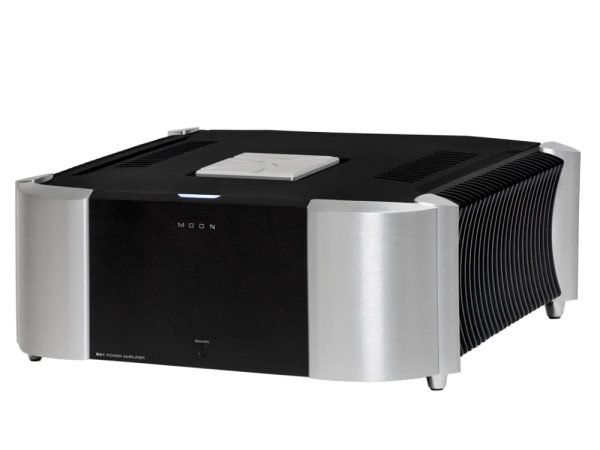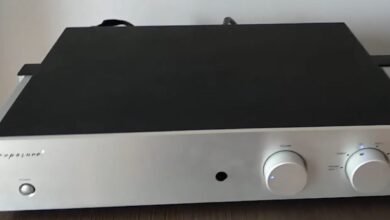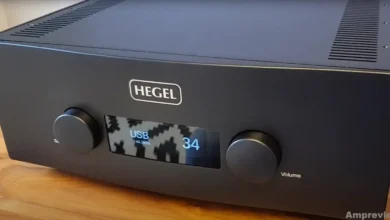The North collection is a new addition to the Moon by Simaudio lineup, and the collection itself lives partly in parallel with the main lineup. It may gradually replace the existing lineup, although it is unlikely that it will completely replace it: after all, the North components are top or pre-top models in certain numbered lines.
So, the preamplifier and digital player 891 tested today is probably the older version of the combination of these two functions. There is a separate 850th dual-block preamplifier, but it does not have a digital part. Pure digital players end with the 681st model, which can be equipped with a separate power supply, but in terms of filling and functionality, this device is somewhere close to what is built into the 891st. The Moon by Simaudio 861 power amplifier will yield only the 888 model.
I got the impression that the North Collection is a kind of compromise between assembling a multi-block system from senior components (a two-block preamp, a two-block player-DAC, a two-block phono preamp, one or two power amplifiers), and making the system more compact, but in terms of functionality almost not inferior to the most senior models in specific lines (the situation with the 600th is similar).

Now let’s see what our test subjects are. The Moon by Simaudio 891 model is a large 25-kilogram device with a 5-inch color display on the front panel and a very solid set of switches on the back. Functionally, it is a preamplifier with balanced circuitry and a built-in MM/MS phono corrector (and, it seems, even on discrete elements), as well as a full-fledged streamer and DAC.
The digital part is more than advanced. There is a full set of inputs for switching (except for i2s), including HDMI Arc – so a stereo system of this level can be used for dubbing movies if you want. Network connection is possible wired and wireless. In addition to the built-in DAC, there is also a full-fledged streamer that works with both its application for smartphones and tablets, as well as with Roon.
The formal characteristics are quite convincing: the device can work with high-res, understands the main streaming services, and can process the music library on external storage. It’s hard to say what else you might want here – everything you need is there for the vast majority of usage scenarios.

What’s inside? There’s not much information here. A proprietary hybrid power supply, an ES9038PRO chip per channel, a volume control built on FPGA, and additional gel decoupling of the device’s filling – that’s in general terms. I didn’t have the opportunity to open my experimental samples, but from what I could find, the device’s element base is quite good.
The control options for the five-inch screen and the app are not limited: the kit also includes a very nice BRM-1 Intelligent Remote Control.
The Moon by Simaudio 861 power amplifier also logically has a balanced transistor circuitry. What’s funny is that the manufacturer specifies “MOON Transistors” among other things. It is clear that the company itself does not produce transistors, but apparently, we are talking about some kind of custom customization.
Otherwise, it weighs 58 kilograms, has dual mono with a pair of toroidal network transformers, no feedback, plus the ability to work in mono mode. It’s hard to surprise anyone with a big, heavy, and powerful amplifier these days, but they are all different, so all you can do is listen.
The last thing I would like to say about the devices is that I really liked the appearance and manufacturing. The corporate style is unmistakably recognizable, and the roughness of the finishing of the junior lines is not even close. And the devices are drawn interestingly, and the hardware is made well.
Now it’s time to move on to listening. And here I need to make one important caveat. The study was not to the extent that I am accustomed to – in a normal case, I would have taken the pre-streamer to myself and tortured it for two weeks, comparing the work of the inputs, and studying the application and its alternatives.
Here, the fact that the sound from different inputs, for example, a streamer and a DAC, will most likely be approximately equal can only be judged by the experience of previous communication with the products of this manufacturer. The same is true with the application – for several years now, the MiND system (a bundle of “brains” and control from the tablet) has worked on average no worse than others, except that with large local music libraries, it did not always work quickly.
In this particular case, I had a ready-made system, control via Roon and Qobuz as a source of test recordings. And several hours of time. Therefore, I can only tell about what I heard in this format, but I have to leave some points without attention.

The test system consisted of a pair of Moon by Simaudio devices, Tannoy Kensington GR speakers, and a Tellurium cable harness. At first, even before listening, there was strong skepticism. I have a complicated relationship with Tannoy, namely Kensington, according to observations, about half of the owners play like a large radio outlet – with the corresponding stage, dynamics, and resolution. Because many do not even know that this speaker system can play differently, and they pass off such a sound as a signature style. Everything is very complicated with the selection of amplification: it needs a lot of it, with good power and good current output.
I started with the recording of Chano Pozo and Dizzy Gillespie’s “Tin Tin Deo”, fortunately, it is available in streaming in very decent high-res quality. The speakers are installed quite close, and due to this (and due to the acoustics themselves) a very focused sound with a great depth of the stage was obtained.
The system copes well with acoustic control. The sound is moderately soft, with good midrange development and a slight emphasis on it. However, the edges of the range, adjusted for the recording, are also developed evenly. No harshness, but there is no excessive softness either, as there is no hint of blurriness or veil.
The main signature in this system is set by the acoustics, but it is important to understand that the acoustics themselves are not at all easy to work with – I have already spoken about this. In many systems with it, coloring and distortions are possible – but here there are none.
Good, natural detail, natural timbre delivery, pleasant localization of images even on a relatively chamber stage. The corporeality and weight of images is delivered naturally, without being inflated or flattened. About the whole sound of this album, it can be said that it is very pleasant, natural, it has its charisma and its mood.
Then I switched to Knock on Wood, “Eddie Floyd”. The atmosphere of a live recording, the volume and air of space, and the overtones are conveyed pleasantly. You can hear a somewhat unusual arrangement of instruments in the scene, but it sounds recognizable and interesting — such an arrangement should be there, that’s how it was recorded. There is separation, there is air.
The presentation is moderately emotional: a little restrained, but without being stiff or cold. This approach is already familiar: I listened to this pair of Moon with other acoustics and the signature was approximately similar – detailed, but unobtrusive, without coloring, even a little detached, but at the same time livelier and warmer than the younger models, with good work on the main parameters.
Calm and meaningful sound, conducive to long, thoughtful listening. And no vulgarity, lack of restraint, emotion – only from the music. The sound itself tries very hard to be neutrally balanced.

The frequency range is worked out confidently, as much as it is on the recording – that’s how it plays out. The quality and quantity of bass are all good, in my opinion, you shouldn’t expect more from this acoustics. However, I repeat, there is no lack or tightness of anything. The same can be said about the rest of the range.
The acoustics’ direction to the listening point is, of course, audible, but the filling in a room much larger than expected for these speakers is also good. Already on the second album, I can say for sure that what is heard is much better than expected.
The third album is Eric Clapton’s “Pilgrim”. A pleasant spherical volume of sound, but at the same time the volume is not crumpled, but quite airy, with a decent separation of parts. The vocals seemed a little darker than usual, but this did not affect the level of detail and fit.
There is bass, not super deep, but confident, well controlled, with enough body. The delivery is a little softer than I expected, but this softness does not at all imply a loss of dynamics or detail: this is simply the character of the combination of acoustics and amplification.
The emotional component of the sound is very good: everything is alive, and there is an effect of involvement, but there is no feeling of over-colored sound, no persistent wow-effect, and subsequent fatigue. But there is no boredom or formality either. Even though I am, I repeat, not a big fan of Tannoy, it is frankly interesting to listen to – and this is the merit of the components.
Then I switched to a completely different genre – I put on Arch Enemy’s “Covered In Blood”. Thick, dense sound, which suits this album very well, but without compromising clarity: it is high, and natural, especially in the vocal range, and the guitars and drums sound very decent. Perhaps this is a big plus for the built-in source, preamplifier, and power amplifier too.
Everything that can be squeezed out of the acoustics is squeezed out, and the result sounds integral, emotional, and rich. It is great to listen to, such heavy rock, this combination turned out to be excellent. From the bass, which turns out to be complex, not monotonous, to the detailed, but not flashy highs – everything is in its place. And there is a stage – dense, but understandable. There is separation, air, and a certain fundamentality of the sound. But the main thing is that such a dense sound does not get boring: you can just listen without adjusting for any simplification. With this album, the results are unconditionally better than expected.

Another genre change – Beethoven’s 3rd Symphony, Vienna Philharmonic, Leonard Bernstein. Quite a believable sound, but with this recording, it turned out a little softer and more intimate. The scale is quite readable, but still, the sound is perceived as a little intimate, which is rarely applicable to a symphony orchestra.
The timbre plays authentically, although the sound of the strings is a little more formal than it should be. Or a little simpler. But such a presentation does not interfere with the perception of the work and the music itself as such, and in general, the sound is both beautiful and captivating – we must give it credit for this. The only thing that surprises me is, again, the scale: I would still like it to be larger. And so – the emotionality and drama of the work is quite within the tract’s capabilities, perhaps with some individual adjustments.
And the last recording in the listening session is Krzysztof Penderecki: “Suite”,. Good sound of the instruments individually, somewhat independent, but at the same time perceived as a whole musical piece, does not fall apart, does not crumble.
In this recording, the sound of each instrument can be considered reliable, and natural, and even the softening inherent in some previous albums is not very noticeable. It is interesting to listen to, there is immersion, and there is atmosphere. Somewhere on the edge of perception, one can still think of a slight smoothing of detail, but nothing more.
Otherwise, it is a full-bodied, neutral, but lively sound, natural, conveying well both the musical idea and the sound of the instruments and the recording features, moderately emotional, without coloring.
Conclusions
The devices objectively have a signature style – calm, analytical, confident, and able to work with complex music. In my understanding, this pair squeezed everything possible out of the acoustics during listening, without making the sound rough or vulgar.
Good work with digital, excellent preamp section, obvious compatibility with the power amplifier – and really good control, dynamics, and detail. It is clear that the amplifier can cope with various complex acoustics, with a tight or complex “hard to penetrate” crossover. And then there are options – the devices have their own style, which is very neutral and unobtrusive, so the combinations can be very different.
Price Simaudio Moon 861 and Simaudio Moon 891
The Simaudio Moon 861 is priced at approximately $22,000.00, while the Simaudio Moon 891 is available for about $25,000.00. These premium audio components are part of Simaudio’s high-end lineup, designed for audiophiles seeking exceptional sound quality and features.
Simaudio Moon 891 Specifications
Analog inputs: MM/MS phono preamp, 1xXLR, 1xRCA
Analog outputs: 1xXLR, 1xRCA
Digital inputs: AES/EBU, 2xSPDIF RCA, 2xToslink, USB-B, USB-A (host), HDMI Arc, LAN, Wi-Fi, Bluetooth
Auxiliary switching: MOONLink, 12V trigger, optional power supply connectors
Gain: 13.5 dB
Phono gain: 40/54/60/66 dB
Impedance: 10 / 100 ohms / 1 / 47 kiloohms
Capacitive equalizer setting: 0 / 100 / 470 pF
Output impedance: 50 Ohm
Frequency range: 2 Hz – 200 kHz (+0 dB / –3 dB)
Channel crosstalk: -125 dB
Singal/noise ratio: 125 dB
THD: 0.0003%
Weight: 25 kg
Dimensions (WxHxD): 481 x 14 x 449 cm
Simaudio Moon 861 Specifiactions
Output power: 300W/8 Ohm, 600W/4 Ohm, 800W/8 Ohm in mono mode
Input sensitivity: 1.4V
Input impedance: 47 kOhm
Gain: 31 dB
Frequency range: 2 Hz – 100 kHz (+0 dB / –3 dB)
Channel crosstalk: -119 dB
Singal/noise ratio: 119 dB
THD: 0.002%
Damping factor: 900
Dimensions (WxDxH): 481 x 21 x 609 mm
Weight: 58 kg





GIPHY App Key not set. Please check settings